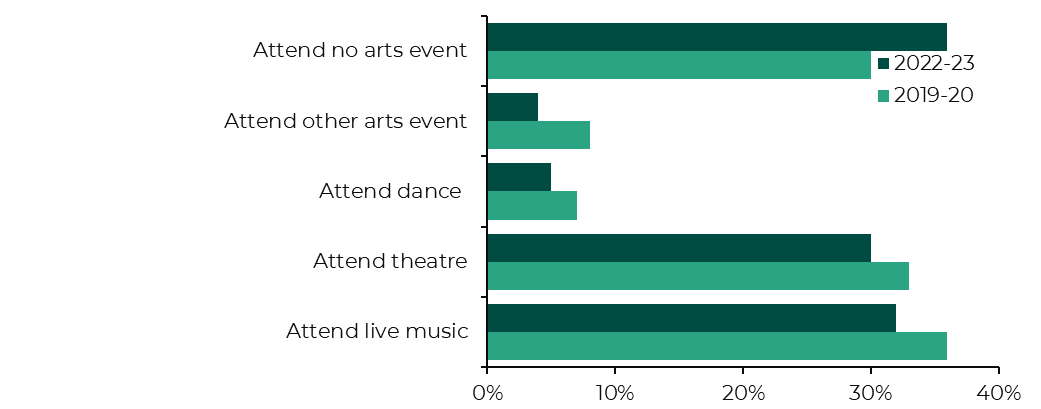This is the eighth article of our ten-part series looking at the Welsh Government’s progress in delivering its Programme for Government. Here we explore the well-being objective to “Push forward towards a million Welsh speakers, and enable our tourism, sports and arts industries to thrive”.
There are 14 specific commitments beneath this broad Cabinet-wide objective, which the Welsh Government has given an update on in its PfG annual report. There are also relevant Ministerial commitments.
Browse our full #ProgrammeforGovernment series, published to date.
Cymraeg 2050, the Welsh Government’s 2017 Welsh language strategy, set an ambitious target to increase the number of Welsh-speakers to a million by 2050, and double its daily use. It seeks to reverse the recent trend in Census data, which saw the percentage of Welsh speakers fall from 19% in 2011 to 17.8% in 2021.
The Minister for Education and Welsh Language described the results, which included a 6 percentage point decrease in young Welsh-speakers (3-15 year olds), as “disappointing”. Over three decades, the Census recorded increases in the percentage of young Welsh-speakers, reflecting growth in Welsh-medium education over that period. But with all local authorities now reporting a decrease, is the ambition of a million Welsh speakers achievable?
“All pupils in Wales to become confident Welsh speakers”
The percentage of Year 2 pupils (7 year olds) taught Welsh as a first language has remained steady over the past decade (22.2% in 2011/12 - 23.1% in 2021/22), with the Welsh Government missing its target to increase this to 24% by 2021. The First Minister recently announced a Welsh Language education bill would be introduced during 2023-24. The Bill will aim to support “all pupils in Wales to become confident Welsh speakers”. It will seek to reform how local authorities plan and promote Welsh language provision, and provide a catalyst for moving schools along the Welsh-language continuum.
Investment is key to developing Welsh language education provision. In November 2022, the Welsh Government approved £7.1m in funding for 2022-23, on top of £30m in Welsh-medium capital grants previously announced to increase capacity in Welsh-medium schools. It is also allocating £2.2m per annum for the remainder of this Senedd to develop Welsh language late immersion provision. This funding supports pupils that enter Welsh-medium education late. While some authorities used this funding to boost existing provision, eight authorities, including Torfaen, Blaenau Gwent and Merthyr Tydfil, created their first ever late immersion centres.
Implementing Welsh language standards
Developing Welsh language capacity within organisations is key to increasing its daily use among the workforce and with service users. The previous Welsh Language Commissioner expressed frustration at the limited progress in introducing further Welsh language duties, with only one set of Welsh language standards regulations passed by the Senedd in the last four years. The Welsh Government reviewed the process following a Senedd Committee recommendation, fulfilling its Programme for Government (PfG) commitment to streamline the standards. It implemented these changes within the new standards Regulations for healthcare regulators, ensuring they “contributed to increasing the use of Welsh”.
The Welsh Government recently introduced draft regulations for water and sewerage bodies, intended to promote and facilitate the use of Welsh with the public. Further regulations are planned for public transport and housing associations.
Cymraeg 2050 said the initial years of the strategy would “focus on laying the foundations”, supporting an increase in Welsh speaker numbers in the future. Whilst current data isn’t encouraging, policymakers will hope that actions translate to results soon.
Are the arts, sport and tourism thriving after an existential crisis?
Since the pandemic began in early 2020, arts, sports and tourism organisations have faced existential threats on a scale otherwise unknown to them in our lifetimes. Against this backdrop, a Welsh Government goal for them to “thrive” may seem ambitious.
The Senedd elections in May 2021 came just as indoor live performances were possible, subject to COVID control measures, for the first time in Wales since the first lockdown. Normality reigned briefly from August 2021, before measures were reintroduced in response to the surging Omicron variant later that year. It was only in April 2022 that normal business resumed, just as inflation surged, driven by increased energy costs.
Out of the frying pan…
During normal trading, smaller arts venues operate with tight – if any – profit margins. These are being squeezed with inflation along their supply chains and reduced incomes, as attendances remain below pre-COVID levels. Some sports also face specific issues, for example high energy consumption, as well as cost increases for vital chemicals, leaves swimming pools particularly vulnerable. “The crisis now facing the sector”, the Arts Council for Wales told the Senedd’s Culture Committee in September 2022, “is as great as at any time over the last two years”.
Arts attendance (2019-20 and 2022-23)

Source: National Survey for Wales
Music Venues Trust has warned that “2023 will be the worst year for closures” of grassroots venues since the charity was founded in 2014. Across the UK, the number of events hosted at grassroots music venues is down 17% compared to 2019.
The situation for sport is more nuanced. Adult participation in sport three or more times a week is up to 39%, a six percentage point increase from pre-pandemic levels. But 38% of adults say that the increased cost of living has reduced their ability to be active. Meanwhile, young people are doing less sport outside of school than they were in 2018, with a widening gap in participation between those from most and least-deprived backgrounds.
Modest funding increases outstripped by inflation
The Welsh Government spent over £140m keeping culture and sports organisations afloat during the pandemic, preventing widespread permanent closures. But it has been reluctant to provide bespoke funding to help the same sectors weather the cost-of-living storm, despite calls from the Senedd’s Culture, Communications Welsh Language, Sport, International Relations Committee (Culture Committee) and Local Government and Housing Committee.
Instead, it’s provided a modest revenue uplift to the main publicly-funded bodies in these areas – 3% for the Arts Council, 7% for the National Museum and National Library and 5% for Sport Wales in the 2023-24 budget (inflation is currently 7%).
The Deputy Minister for Arts, Sport and Tourism rejected the Culture Committee’s call to discuss a UK-wide culture and sport emergency funding package with the UK Government, saying “this is wholly a matter for UK Government”.
Since 2016 the Welsh Government has been exploring proposals for a National Contemporary Art Gallery. A 2018 feasibility study proposed a “distributed model” – with 8-10 regional sites and an anchor hub – the running costs of which would be more than the Arts Council’s total annual allocation for the visual and applied arts. Although building work is yet to begin, the Welsh Government is continuing along the course charted pre-pandemic and before inflation soared. Does this still look as wise a use of finite resources as it did in 2018?
A gathering storm
In September 2022 the UK Government’s Energy Bill Relief Scheme provided a lifeline for those dealing with spiralling energy costs. From April 2023 the UK Government has provided pared back support, although some sectors – including museums, libraries and historic sites – are receiving extra help. Music Venues Trust said that the new scheme is “so insufficient that it must inevitably result in permanent closures of venues.” Sport association UK Active said that it will cause “further service restrictions, closures, and job losses”.
With energy costs predicted to remain above 2022 levels until the late 2030s, reduced incomes and government support, how will arts and sports cope with energy bills this winter?
“Challenging to remain profitable”
Accounting for 11.3% of employment and 5% of GVA, tourism is one of the most important sectors of the Welsh economy. Equally well known are the challenges the sector has faced over the last three years, first from the pandemic and more recently from increases in the cost-of-living.
The findings of the latest Welsh Government survey of tourism businesses, published in June, explain that:
High operating costs and limited scope to raise prices during a time of high cost of living for consumers make it challenging [for tourism operators] to remain profitable.
Visitor levy
The Welsh Government has a PfG commitment to “introduce legislation permitting local authorities to raise a tourism levy” (now referred to by the Welsh Government as a ‘visitor levy’). It’s consulted on proposals to introduce a discretionary levy on overnight visitors to:
…provide a means to generate revenue for local authorities to invest into local services and infrastructure which is integral to the visitor experience.
78% of respondents disagreed that local authorities should have the power to introduce a visitor levy. However, the Welsh Government’s analysis of responses showed that “most of the respondents who elaborated on the reasons behind their view on this question focused on the local or central aspect of implementation, rather than the implementation of the levy itself”.
This issue will no doubt feature heavily in the scrutiny of the legislative proposals when they are introduced to the Senedd, which is expected before the end of 2024.
Explore the Programme for Government, its objectives and commitments
- 1. Provide effective, high quality and sustainable healthcare
- 2. Protect, re-build and develop our services for vulnerable people
- 3. Build an economy based on the principles of fair work, sustainability and the industries and services of the future
- 4. Build a stronger, greener economy as we make maximum progress towards decarbonisation
- 5. Embed our response to the climate and nature emergency in everything we do
- 6. Continue our long-term programme of education reform, and ensure educational inequalities narrow and standards rise
- 7. Celebrate diversity and move to eliminate inequality in all of its forms
- 8. Push forward towards a million Welsh speakers, and enable our tourism, sports and arts industries to thrive
- 9. Make our cities, towns and villages even better places in which to live and work
- 10. Lead Wales in a national civic conversation about our constitutional future, and give our country the strongest possible presence on the world stage
Article by Osian Bowyer, Robin Wilkinson and Ben Stokes, Senedd Research, Welsh Parliament
*This article was amended 23/1/24 after the Welsh Government identified an error in its National Survey 2023 results. The clause "with the number of people attending or participating in a cultural event three or more times a year down from 70% to 65%" has been deleted.






